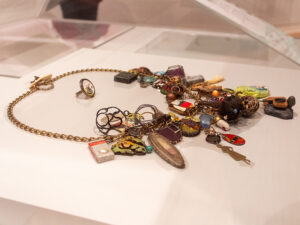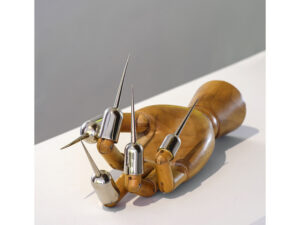I was lucky enough to encounter Lisa Gralnick: The Gold Standard in three ways: as a viewer looking at the show; during a private floor talk with Gralnick; and as a reader of the exhibition catalog. A review usually collapses these three stages together, into a seamless text that is informed by many sources of information and in which the gaps in knowledge, interpretation and the stages by which you come to make a judgment, aren’t visible. Looking over my notes, I decided that I like the different modes of examination and how they build into a picture of Gralnick’s work and the experience of encountering it in this exhibition project. Hence a review in three parts, which starts with looking at the show, continues with notes made while listening to Gralnick talk about her work and concludes with a consideration of the catalog and what other writers have to say.
Looking, Firstly

Up first is The Gold Standard: Part I, which consists of a series called ‘Commodification and Sensible Economy.’ Selecting a series of objects from her everyday life, Gralnick purchased a certain amount of gold ‘derived through a calculation of the market value of the object and the value of gold per ounce at a set date.’ The gold in question is then used to fabricate part of the object, the rest being cast in plaster. The effect is artful, interesting and sometimes surprising. The museum made a bold decision to leave these objects open to the viewing audience, with no vitrines to get in the way, which somehow intensifies their effect, the way these objects oscillate between the real and unreal. (They are real – actual plaster objects – and unreal – fake plaster copies – and unreal – the traces of an exchange, no longer accessible to us – and real – using actual gold – and so on.) It is a dizzying and intelligent play.
Some of these objects work better than others, which seems to be a product of various factors colliding around the specific objects – the richness of exchange as a metaphor, the character of the object itself, the juxtaposition of size and value, etc. #17 Duncan Painting in Frame (2009) is excellent, because it attaches to the idea of the masterpiece and thus to other systems of value, as ludicrous and powerful as gold itself, which is also what animates #11 Tiffany Ring (2005), in which the extraordinary value of diamonds bought so much gold the object had to be supersized in order to use it all. #13 Hoover Vacuum (2006) is a smart object, lending itself to a neat critique of society’s lack of value for domestic labor, a massive and unvalued contribution to the economy. #1 Sink (2003) is also excellent because it is an object of use, a real tap handle that might as well be fake since it can never be used (not only because it is a work of art, but because its style is too prosaic, not at all what someone who could afford gold tap handles would want in their bathroom.) The least interesting is #15 $100 Bill (2006), since there is little that is surprising when one mechanism of exchange is translated into another. Gralnick’s work is usually too smart and funny (#6 Zoloft and #8 Rhinoplasty are delightful in their willingness to traffic in the potentially compromising dimensions of modern desire that The Gold Standard tackles) to take such an obvious route.
The Gold Standard: Part II showcases a body of work called ‘Phenomenology and Substantialism.’ ‘Born out of the artist’s need to purchase gold, a material frequently too expensive for artists to work with, Gralnick melted down objects to mine their material value,’ notes the wall text. ‘Before destroying the objects, Gralnick recorded her transactions, along with bits of information she gathered about them, then documented each by way of a plaster cast.’ These works occupy two wall plinths that run down the sides of the gallery, marking the transition from Part I to Part III of the exhibition. The wall text suggests that the old typewriter technology used to create the labels for these cast objects is a nod to the history museum. In each case Gralnick gives us a tiny piece of the original gold. These are nice – the wall text describes them as ‘like grave markers which themselves will disintegrate over time’ and thus activates the fragility of memory and remembering. The plaster models are quite beautiful, delicate traces of the original jewelry captured in the plaster. But what of the gold standard? The price by which Gralnick acquires the gold is still fixed by the London exchange, as in the earlier series, but what else does gold regulate in these works? The gold fragment is evidentiary, proof that the plaster cast does indeed represent objects that existed and this is a kind of gold standard, gold as regulator of memories. There is of course the juxtaposition of ‘priceless’ personal associations butting against the cold calculation of gold’s value, but this is not as witty and thought-provoking as the explorations in Part I of the exhibition.
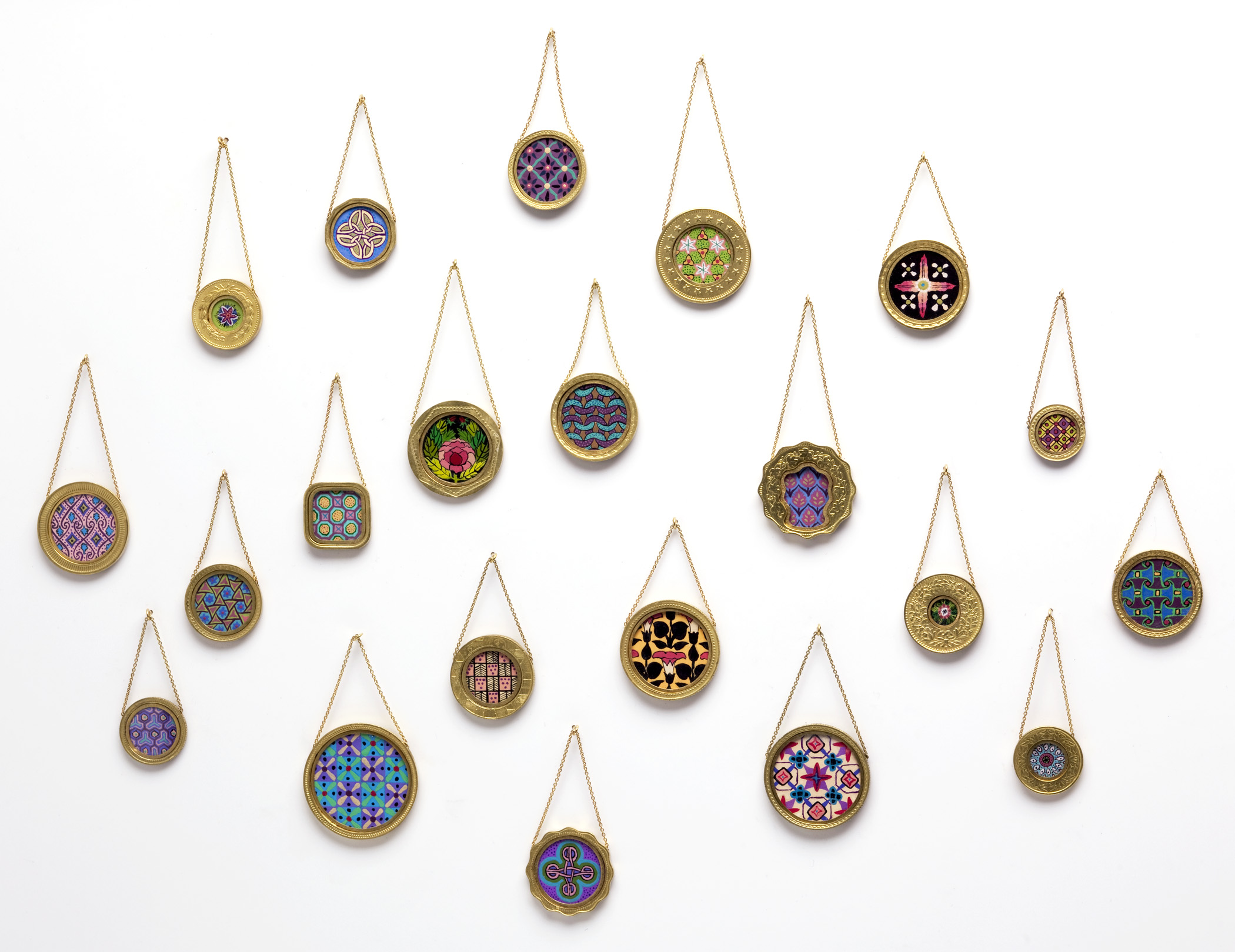
The works in this section of the exhibition are mounted on the walls and on plinths. They are also sealed off behind glass, but somehow this is entirely appropriate, an apt aping of the conventions that surround historical jewelry. (The museum doesn’t do a kind of violence, as it would have with the earlier objects, by placing them behind glass, since historical objects are never worn.
I found it very difficult to understand how the gold standard established in Part I, and still regulating Part II (if not quite so powerfully) was at play in Part III of this exhibition. Made of gold and, I suppose, a demonstration of gold’s mutability, its ability to move through history intact and yet subject to endless melting and reshaping into new objects, these objects don’t engage with the various associations of the gold standard in the same way as the earlier series. The wall text suggests that ‘To complement this faux-historical nature, Gralnick employs museum-like presentation methods within the works by her use of vitrines and labels, lending them a false sense of authority.’ This is indeed a system of value and authenticity as open to rich critique as the value and authenticity of gold, but what do these two systems of authority have to do with each other? The museum might display gold but its value and authority is not founded on, or regulated, by gold.
Thinking about this exhibition as a totality, I am grateful for the opportunity to see three bodies of work in detail and to be able to explore the way Gralnick’s thinking shifts over eight years of investigation, but disappointed by the curatorial timidity on display. It makes sense to work within a framework established by the artist and her practice, since it ensures coherence and a respect for what matters to the maker. I found myself wondering, however, how this exhibition might have been improved by extending the notion of value beyond that of The Gold Standard and demonstrating the way a critical investigation of value is at work within the rest of Gralnick’s jewelry. Value is, among other ways, established by contrast and in this case a singular focus on the precious yellow metal felt like a kind of seduction that didn’t necessarily benefit the exhibition’s critical perspective. Gralnick’s thoughtfulness is on show, but it seems as though the curator, Nora Atkinson, has left too much of the investigation of value to the maker.
I also have to say that the historically literate fakes in Part III of the show seem the least interesting to me. They are skillfully done on a technical and conceptual level and in works like Military Brooch 1940 (2007) Gralnick manages to establish some fascinating equivalences between her biography and the particular cultural dimensions of gold’s malleability. (The references here are to being Jewish and the macabre extraction of gold fillings from Nazi concentration camps, plus gold’s value because of its portability and mercurial ability to change form without loss of quality.) What these works don’t have, though, is the razor-sharp and head-on tackling of gold’s mythology that is so effectively achieved by the works in Part I through the simple and yet satisfyingly complex decision to put gold’s nature as a mechanism of exchange and value on display. Part III replaces gold’s existing myths with new (and pointed) myths controlled by the artist. I can see the artistic process that led to this body of work and which gives it integrity as part of Gralnick’s production, but to my mind gold’s allure and cultural power can absorb and accommodate Gralnick’s new mythologies in a way that doesn’t happen with Part I.
Listening, Secondly
This exhibition represents eight years of work and it is informed by different influences: a move to Wisconsin, looking at houses and feeling poor, weighing her gold jewelry to see if it would melt down to a sufficient value. Also the institutionalization of art as part of thinking and teaching – museology, the preservation of art works, the way much art has no intermediary life but goes straight to the museum from the artist’s studio.
The Gold Standard: Part I
Gralnick is very interested in iconological debates held in the seventh and eighth centuries about images of Jesus Christ and the relationship between the real and the image. Representation as a metaphor: one thing representing another in a different form. Beyond our visual experience of objects is another experience of objects within a system of relative value. The work is an ultimate representational truth and an ultimate folly, since this capturing of value and exchange is only true for one moment in time.
In general, objects have value beyond what they are worth. We keep them around because of these larger purposes and meanings. Some objects date quite specifically and are not iconic. Others are iconic, outside of time. Gralnick has deliberately selected objects along these lines, or for the ways objects read as having a period quality or not. (e.g. the fabric imprint on the plastic bag of the vacuum cleaner locates it quite specifically in time.)

The Art & Language book (#2 Book, 2003) fits with the larger systems of representation that Gralnick was exploring at the time. She specifically chose the chapter titled ‘Against Creation As Translation’ because of her belief that meaning isn’t possible without language.
The ring (#11 Tiffany Ring, 2005) hangs at groin level like a penis ring, since Tiffany functions as a sign of male power – expensive purchases for the display of property (mistress or wife).
The sink (#1 Sink, 2003) was the first piece made as part of the series. The very first ones could be worn as jewelry. The chain for the nose was made after the fact, so that its owner could wear it.
The Gold Standard: Part II
The dynamic of acquiring gold in this way was partly to do with the awfulness of extracting the metal from the ground, but the greater impulse was about narratives and the history that comes with existing gold jewelry. Do we read these objects without the gold? Do these objects transform when the gold is removed? There is also a mix of objects: personally charged objects and objects without any great personal value. There is no underlying approach in terms of which objects are acquired and documented; no attempt to find certain kinds of objects.
The display relates to museum practices of the 1950s and 1960s, when labels were hand-typed on machines. There is a lot of subjectivity in the old methods, which is not present in the new style of designed labels. In older labels there was an intimate connection between the objects and the person describing them. These works represent a desire to achieve a balance between too much staging and a too-casual display. It is important to show respect, but not too much.
The Gold Standard: Part III
Gralnick decided quite early that all the gold in Part II of the exhibition would go into Part III, but there is no attempt to match old objects to new works. The history of the gold is precisely not knowing where it came from or what has been melted down. The work in Part III represents Gralnick’s desire to carry this aspect forward.
In Part III, the gold standard is about rewriting history. An exchange in the metaphor of gold turning from one thing to another. It is also about how objects mediate history. Objects that have survived have a huge bearing on what we know of
– and think of
– the past.
Gralnick calls these historicized objects, partly based in historical truth and partly based on made-up or imagined narratives and fables. She doesn’t like the idea of style. Part III of this exhibition facilitates an ultimate eclecticism, a total freedom in making each work.
The first work made for the series was the Victorian Chastity Belt Necklace (2007), modeled on iron chastity belts. It explores the tensions of the Victorian period: a time of repression and yet an opening up of the world through discovery in science and culture.
Military Brooch, 1940 (2007) has melted gold and gold chains that Gralnick purchased and kept as chains – a way of emphasizing objects ripped off a prisoner in a concentration camp. It is about leaving the history in place, rather than eradicating it through melting.
Tool, Medical Device or Implement (2007) is about the ambivalence of objects when we don’t know what they are, or what they were used for.
Fringe Necklace with Ball and Chain (2008) is based on the Troy fringe necklace but updated, made more sophisticated. This is a treasure with a sad and complicated history that ties into awful aspects of colonial history. The twentieth-century addition is about nationalism, the issues of borders that are played out in the history of the original necklace and treasure.
Coin Collection Picture Gallery (2008) has a real gold frame, with tempera paintings inside. They are cast from actual coins, kept in the drawer underneath; objects that exist in the murky area between art and not-art objects and also a dialogue in terms of pattern, taken from history of design.
Hair Noose, 1920 (2008) is made from actual pieces of Victorian hair jewelry. These are damaged originals, which were chopped up and then reconnected by gold. Victorian mourning jewelry. The tassel is lightness and frivolity, contrasted with the obsession with death, rituals that are dark and grim.
Fourteen Unusually Small Rings (2009) can be worn. They vary from the clearly unwearable to those you could almost imagine being worn. This is a jeweler’s revenge piece: Cartelac the goldsmith, who murdered society women to get back his jewelry. There is a Cartelac Syndrome – artists who can’t be separated from their work. The stones in these rings were mostly acquired for this series, rather than coming from the jewelry collected/acquired in Part II. The stones are equivalent to the gems that were being used in jewelry in 1710, facetted and set.
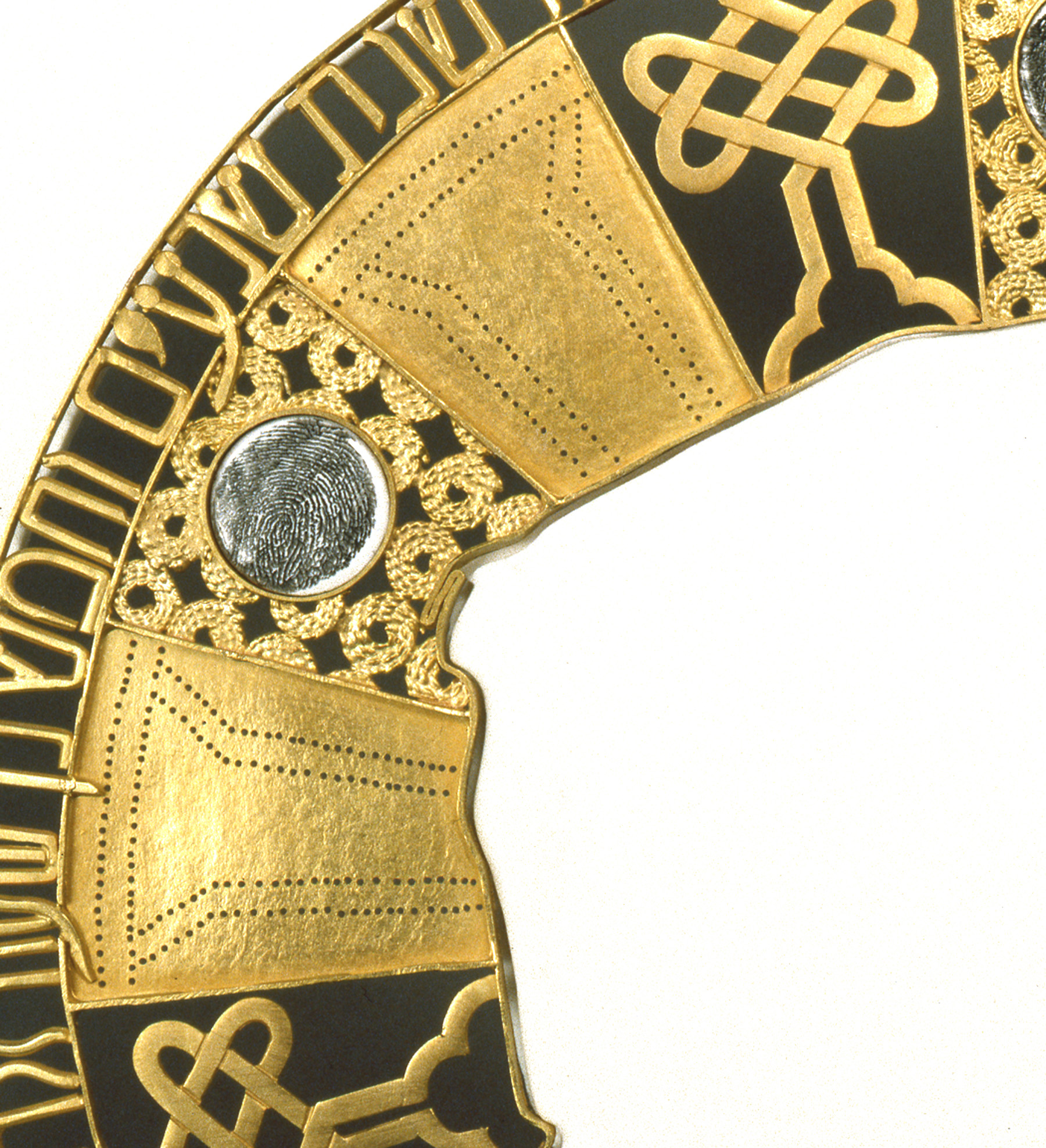
Dave Hickey talks about the panopticon in his book Invisible Dragon as a notion that makes an avant-garde impossible. Foucault’s Panopticon (2010) is a reverse panopticon. We are all criminals and can see around/behind us. Thus this work is an antidote to the general feeling of surveillance that permeates society.
Reading, Thirdly
Lisa Gralnick: The Gold Standard is a substantial hard cover publication with a large square format that enables the work in the show to be reproduced at a grand scale. It is probably necessary, given that so many of Gralnick’s works approach the scale of sculpture (objects and plinths) rather than wearable jewelry. The illustrations are good quality, registering the subtleties and details of the work, while a number of close-up and detail shots point attention to specific aspects of the work being discussed in the essays. The grey background used in the photographs does highlight the shimmer of gold, but it is also a little old-fashioned, a deadening of the objects that somehow doesn’t serve their conceptual investigation as well as it might. Still, these are small quibbles. It is an impressive publication that achieves a high production standard.
Along with being well illustrated, the catalog comes with suitable attributes of scholarship, such as a checklist of the exhibition and a chronology which provides details of Gralnick’s education and exhibition history. This is generally solid but it would have been good to have a bibliography of Gralnick’s own writings and other people’s commentary. (Where an exhibition had a catalog, this information is noted, but it isn’t the same as seeing, at a glance, the literature that frames Gralnick’s work within art history.)
Text-wise, the catalog has the obligatory director’s foreword, an interview with Gralnick by Nora Atkinson, the exhibition’s curator and essays by Michael Jay McClure and Tacey A. Rosolowski. First up is ‘Deregulation: Lisa Gralnick,’ in which McClure examines the way in which Gralnick’s work ‘transfigures the relationship between owner and object.’ As McClure writes, ‘Gralnick’s work rests on the intersection of commodity and character. And the value of the title The Gold Standard seems to reference, by turns, what is held dear and what is heartlessly and systematically sold.’
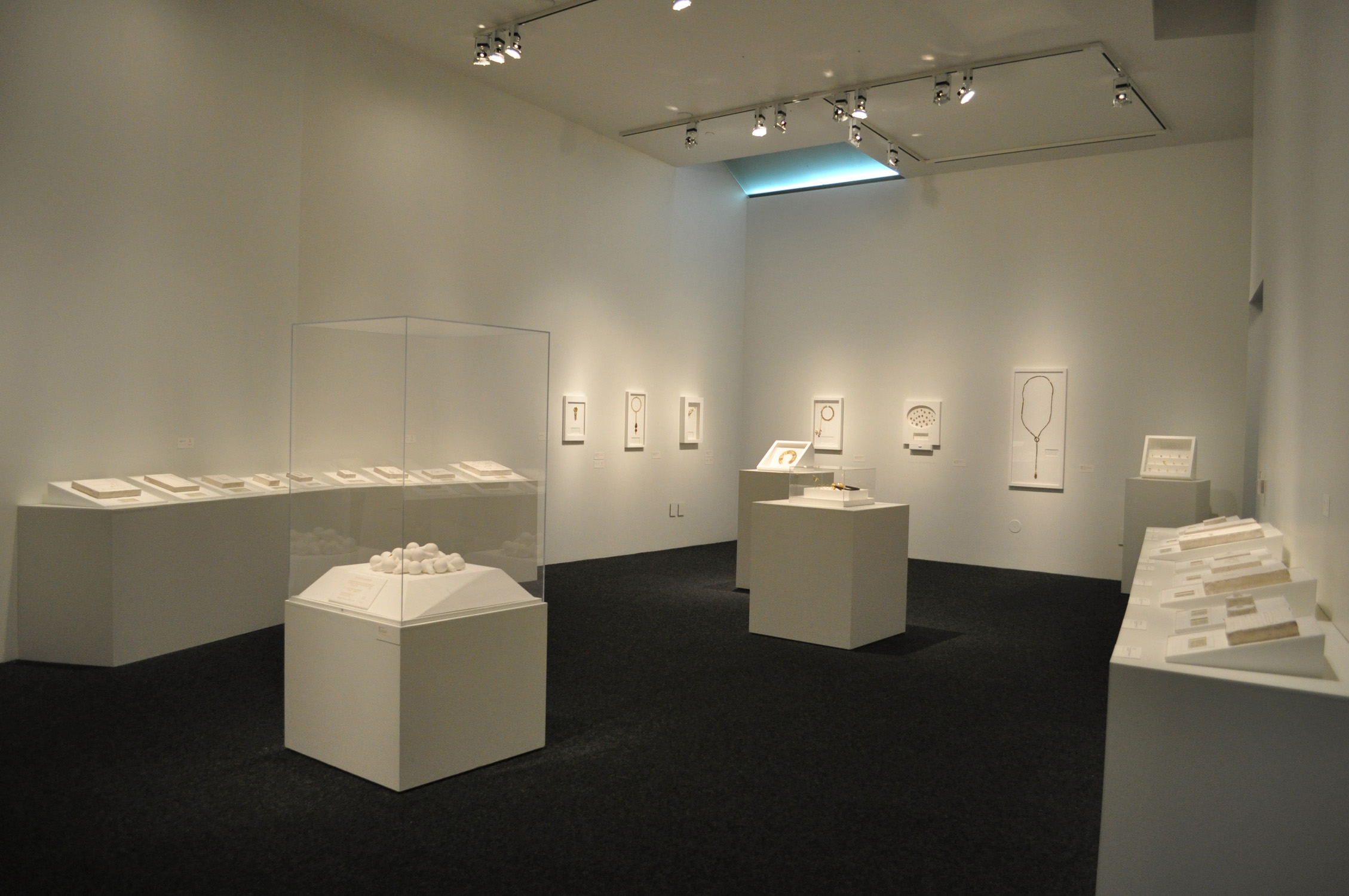
In his analysis of the works in Part II, McClure is equally sharp. He writes, ‘The documenting of [gold’s] past material state, then, becomes extremely complex, because no matter from whom or where Gralnick received this gold it has already been transmuted. No gold object exists, in fact, in original, unmined, material form. To have a gold object is to possess a secondary object, and thus Gralnick documents a material that already documents its own removal from an origin.’ Gralnick’s plaster casts, in other words, point out the lack of originality that gold’s shimmer blinds us to. Singularity and rarity, which we believe to be part of gold’s nature, are a beautiful lie and since Gralnick’s plaster casts arrest this process, her copies arguably offer more in the way of the singular and unique object than the gold original.
One of the really nice touches in the essays published in this catalog is the way they reflect the exhibition experience. The work is grounded in the venue of the gallery. ‘But as you look around this exhibition, its objects neatly behaving in their vitrines, under glass . . . .’ writes McClure, while Tacey A Rosolowski begins her essay by recreating what visitors survey when they tour the show. It is a simple conceit, but an effective one. Rosolowski’s essay continues by talking about language (text panels, as well as art history in general) and the way craft, along with other language resistant art forms such as dance or performance art, have been marginalized because they do not easily accept linguistic tags. The Gold Standard, she writes, ‘opens a space for engaging with different kinds of objects and for systematically thinking out how they function as representations and non-linguistic sign systems.’
Rosolowski’s essay bears the main weight of accounting for Gralnick’s work: its circumstances of production, the conceptual elements from which it is made. Unlike McClure’s essay, which gets to theorize independent of the maker, Rosolowski quotes Gralnick but this doesn’t mean there is a lack of acuity. Take, for example, this discussion of the plaques that accompany each of the plaster casts in Part I: ‘The plaques add nuance, underscoring the economic conditions shaping art’s production, display, and transformation in late capitalism. Painted off-white, the incised letters and numbers pick up reflections from the context and occasionally glimmer as if themselves brushed with gold. Even from a distance the noble metal ennobles the pedagogic function and truth value of linguistic and numeric information, no matter how effectively these reduce the objects themselves.’
Rosolowski addresses the importance of museological shifts in Gralnick’s work, which move from sculpture and art (and the devices of the art museum) in Part I to the museum of natural and social history in Part II. And this, according to Rosolowski by way of Miguel Tamen, represents the latent hostility that museums actually show towards objects. Museums eradicate the singular histories of objects by turning them into representations of a class of objects, which as Rosolowski shows is closely aligned to Gralnick’s point, the cast jewelry being ‘signifiers of the earthbound, pawnshop truth that gold represents cash, a role Gralnick underscores by naming them simply with the date of her purchase.’ This leads Rosolowski to claim that the objects in Part III of the exhibition shift again in their strategies because they are not reduced by the museum, not subject to the logic of the copy, not removed from the world that created them – even if that world is imagined, an historicized fiction.
The final component of the publication is an interview between curator Nora Atkinson and Gralnick. This is a very good example of its type, a free-flowing discussion in which judicious and informed questions elicit the information surrounding how The Gold Standard series came into being. There are originary moments and flashes of inspiration, explanation of sources and a strong insight into how Gralnick narrates her process and views her own work. The text is edited so as to retain traces of its origin as an interview, the rhythms of speech as opposed to writing. One of the best sections of this interview is when Gralnick talks about her difficulty leaving behind the context of jewelry, as expressed in pins that she half-heartedly added to the backs of the earliest works in the series. And it is also interesting to hear her talk about instances of difficulty in melting down the jewelry she acquired in Part II of the project. Atkinson doesn’t forget her art historical duties either, covering subjects such as the shift in label technology (from precise plaque to typewriter to hand-written) and the origins of the titles for the three bodies of work.
At one point, Gralnick and Atkinson talk about an earlier group of works involving gold, in which Gralnick invited a number of people to pay for the raw material so that she could ‘chop into a sheet of gold in the same fearless way that I was chopping into a piece of plastic.’ A transaction in which Gralnick threw in the labor for free so she could cover the high cost of gold, this body of work seems highly relevant to The Gold Standard and yet we are not shown any images of it.
One of the great things about this project is the way that Gralnick plays with an interesting aspect of contemporary jewelry – the fact that the introduction of artistic intentionality into the production of jewelry has arrested the endless mutability of precious materials. If the gold that finds its way into Gralnick’s The Gold Standard has been melted and reforged numerous times, with no evidence of these changes (as Gralnick demonstrates in Part II, in her attempt to record this process) then its amnesiac journey through history has now come to an end. As a product of Gralnick’s artistic and critical practice, gold has been stamped with a quality of originality and uniqueness that will not allow the raw material (plaster, cheap; and gold, precious) to be reused. Unless, of course, there is a massive shift in critical opinion and Gralnick is forgotten.



